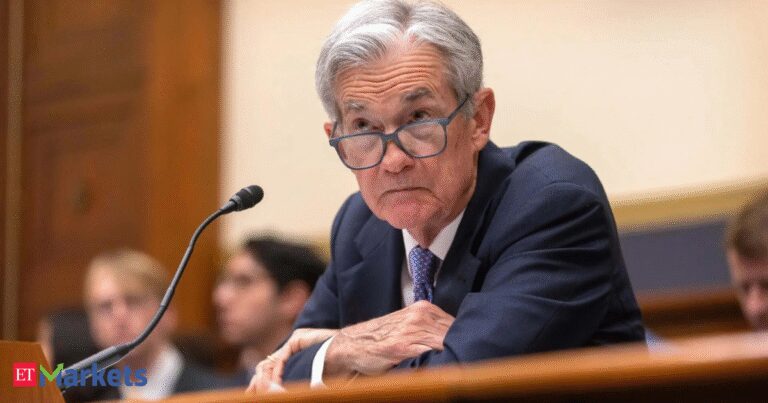In a widely-anticipated speech at the central bank’s annual retreat in Jackson Hole, Wyoming, on Friday, Powell said the economic outlook “may warrant adjusting” the central bank’s stance on monetary policy. The comments sent stock and bond markets soaring as traders took the comments to suggest policymakers will definitely cut interest rates when they next meet in mid-September.
The S&P 500 Index was poised for its biggest gain since May, while yields on benchmark US Treasuries tumbled, foreshadowing lower borrowing costs throughout the economy.
Lost in the knee-jerk celebratory reaction was some of the nuance of a speech that was fundamentally about trying to balance dual risks from both the labor market and inflation. Then there’s the awkwardness that if the Fed does cut rates, it may be because the economy is in trouble and it has to, not because it can due to tame inflation.
Indeed, Powell acknowledged that policymakers face a tricky task under their dual mandate to promote maximum employment and stable prices. Despite a low unemployment rate, the labor market data has started to wobble even as reported inflation remains slightly above the Fed’s 2% target. Here’s how Powell put it (emphasis mine):
When our goals are in tension like this, our framework calls for us to balance both sides of our dual mandate. Our policy rate is now 100 basis points closer to neutral than it was a year ago, and the stability of the unemployment rate and other labor market measures allows us to proceed carefully as we consider changes to our policy stance. Nonetheless, with policy in restrictive territory, the baseline outlook and the shifting balance of risks may warrant adjusting our policy stance.For good measure, Powell added that, “Monetary policy is not on a preset course.”
 Bloomberg
BloombergWhen one of its two goal variables is wildly out of whack (as it was with 9.1% inflation in 2022, for instance), it can be relatively easy for the central bank to forge consensus for policy action. But in recent months, economists and policymakers have started to disagree about an economy that’s mostly fine based on backward-looking data, but in some ways unsettling. In that context, July’s decision to keep rates on hold at 4.25% to 4.5% gave rise to two dissents from Fed governors, the first time that’s happened since 1992.
Adding to the confusion is the fact that immigration policies are now curbing the supply of labor, meaning it’s harder to know exactly what level of payroll growth is necessary to keep the unemployment rate from drifting higher. “Overall, while the labor market appears to be in balance, it is a curious kind of balance that results from a marked slowing in both the supply of and demand for workers,” Powell said Friday. “This unusual situation suggests that downside risks to employment are rising. And if those risks materialize, they can do so quickly in the form of sharply higher layoffs and rising unemployment.”
The main reason for Fed cuts, in other words, is that policymakers are worried about economic deterioration. Powell also noted that GDP growth in the first half of the year was about half of 2024’s pace, driven in part by a slowdown in consumer spending — not exactly the makings of a durable bull market in stocks.
Then there are the risks to inflation. Many economists continue to worry that President Donald Trump’s tariffs will push prices on goods up through the coming months and quarters. The impact has been somewhat modest so far, as companies worked through pre-existing inventories and some of them accepted narrower profit margins on sales of imported goods. But for big-ticket products such as new cars, industry insiders still expect price hikes to hit later in the year when the model year 2026 lines come to market.
Whether that’s an argument for tight monetary policy is itself a source of intense debate: Doves say that policymakers should look through “one-off” price level changes and let them fade from the data on their own, while hawks worry that the tariffs are hitting at a time when the nation has already been living with elevated inflation for almost five years — and that the process isn’t unfolding in a quick and tidy fashion. Most economists believe that inflation expectations are a self-fulfilling prophecy, and that societies that become accustomed to inflation as a normal part of life will find it that much harder to root out.
Powell seemed to place himself in the look-through camp on tariff-driven price impacts. And at the margin, that may be one more nuanced reason to read his speech as having a “dovish” bias. But he acknowledged the concerns and declared that “we cannot take the stability of inflation expectations for granted.”
The perception of the speech may help Powell in some ways. In addition to his policy challenges, Powell has simultaneously parried Trump’s demands for significantly lower rates. Trump is also now threatening to fire Fed GovernorLisa Cook due to accusation of potential mortgage fraud, which seemed to align with a White House pressure campaign to gain more sway over the central bank’s rate-setting committee. In no world did Powell’s speech show any signs of caving to Trump, who famously perceives the stock market as a presidential score card.
It may well be that the market is over-interpreting the dovish tilt of the speech, or it may be the investors were positioned somewhat offsides on the belief that the tone would go in a more hawkish direction. The reality was much more humdrum but entirely appropriate for the occasion. Given the data that we have in hand, the Fed looks poised to cut rates as soon as next month and resume a process of feeling its way around after that for the appropriate level of rates to support sustainable growth with low inflation. But the outlook remains highly uncertain, and the process of policy easing may proceed more slowly than markets expect.
